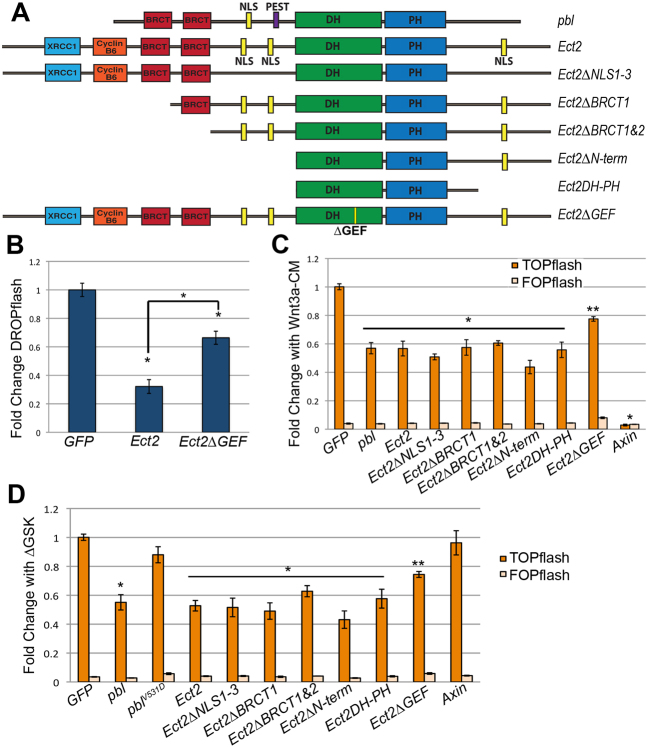Fig. 5.
ECT2 and Pbl modulate Wnt signaling in HEK293T cells. (A) ECT2 domains are similar to Pbl, but ECT2 has a longer N-terminus, no PEST sequence, and multiple NLS motifs. The N-terminus contains regions homologous to human XRCC1, a DNA repair enzyme, and yeast Cyclin B6, a cell cycle regulator. Ect2ΔNLS1,2,&3 mutates all three NLSs. (B) ECT2 repressed Wg-CM-induced DROPflash to 32% of control GFP in S2R+ cells. Mutating the GEF domain as described by Saito et al. (Saito et al., 2004) diminished this effect to 66% of control GFP (*P<0.001). (C) In human HEK293T cells induced with Wnt3a-CM, pbl or ECT2 reduced TOPflash reporter activity to 57% or 56%, respectively, of control GFP, compared with Axin inhibition to 3% of control GFP. Ect2ΔBRCT1, Ect2ΔBRCT1&2, Ect2ΔNLS1,2,&3, EctΔN-term and Ect2DH-PH repressed Wnt3a-CM-induced TOPflash to an extent similar to full length ECT2 (*P<0.001). GEF domain mutations diminished ECT2 repression to 77% of GFP control (**P<0.05). (D) TOPflash induced in HEK293T cells by transfection with ΔGSK beta-cat cDNA, was repressed to 55% and 53% of control levels by co-transfecting with pbl or ECT2, respectively. Ect2ΔBRCT1, Ect2ΔBRCT1&2, Ect2ΔNLS1,2,&3, Ect2ΔN-term or Ect2DH-PH showed similar repression ofΔGSK-induced TOPflash (*P<0.001). GEF mutations in Pbl abolished repression ofΔGSK-induced TOPflash whereas analogous GEF mutations in ECT2 substantially diminished repression (**P<0.05). No changes were observed in FOPflash activity. Error bars represent s.e.m.

